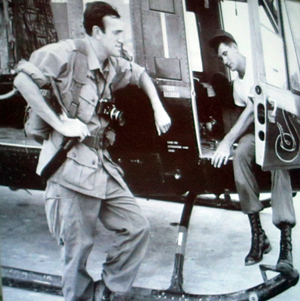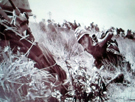
Pulitzer Prize–winning journalist Peter Arnett was the keynote speaker at ProQuest’s annual customer appreciation breakfast on Monday, and with good reason. Arnett, who had covered the Vietnam War for the Associated Press from 1962 to the fall of Saigon in 1975, was single-handedly responsible for preserving the entire archive of unpublished stories and service messages written by the AP’s Saigon Bureau, a repository that is now available in ProQuest’s History Vault collection.
Arnett told the story about this archival rescue: “By 1972, the Associated Press had been reassessing its news role. AP General Manager Wes Gallagher decided that any stories from the Saigon Bureau that were not used should be destroyed. He felt that the ‘only files that matter to us are what appeared on the wire.’
“This came as a shock to me. I knew that the AP was limited technically to a finite number of words every day. In addition to that, during major events like the assassination of President Kennedy or during elections, much war news never made it to the wire.
“I was a loyal AP man, but this material consisted of finely crafted stories by the best war reporters in America who were risking their lives to write them. So I told the bureau that I would undertake the responsibility of ‘destroying’ the files by taking possession of them.”
 Arnett and Saigon Bureau Chief Richard Pyle packed 136 binders of original news into metal trunks and shipped them to the States as Arnett’s personal baggage. It was only in 2005 that he was able to donate them back to the Associated Press’s Corporate Archives. As AP Archivist Valerie Komor (who was at the breakfast) wrote in a 2008 article in the Atlanti (PDF file), “The files are of incalculable value, as they provide a 12-year chronological record of the Vietnam War, the most comprehensive day-to-day account of the conflict that exists anywhere.”
Arnett and Saigon Bureau Chief Richard Pyle packed 136 binders of original news into metal trunks and shipped them to the States as Arnett’s personal baggage. It was only in 2005 that he was able to donate them back to the Associated Press’s Corporate Archives. As AP Archivist Valerie Komor (who was at the breakfast) wrote in a 2008 article in the Atlanti (PDF file), “The files are of incalculable value, as they provide a 12-year chronological record of the Vietnam War, the most comprehensive day-to-day account of the conflict that exists anywhere.”
 Arnett showed many photos taken during his Vietnam years and recounted some of the advice given to him early on by renowned American journalist Malcolm Browne, who took the famous 1963 photo of a Buddhist monk setting himself on fire in protest of the war. “He told me to crawl on the ground, look for cover, and make your way there quickly. Stay away from radio men and medics, as they are prime targets. Stay close to the commander of the unit, because they are always in the safest positions and are the best informed. Try to keep in good physical condition so you can run or march to save your life. And stay away from water buffalos—they will get mad, stampede, and kill you. In a career filled with danger, I was rarely scratched.”
Arnett showed many photos taken during his Vietnam years and recounted some of the advice given to him early on by renowned American journalist Malcolm Browne, who took the famous 1963 photo of a Buddhist monk setting himself on fire in protest of the war. “He told me to crawl on the ground, look for cover, and make your way there quickly. Stay away from radio men and medics, as they are prime targets. Stay close to the commander of the unit, because they are always in the safest positions and are the best informed. Try to keep in good physical condition so you can run or march to save your life. And stay away from water buffalos—they will get mad, stampede, and kill you. In a career filled with danger, I was rarely scratched.”
“Vietnam was the last great print war,” Arnett said in answer to a question from the audience. “Television coverage was very limited. US networks had to send footage to New York to process, so that anything you saw on TV was delayed by at least 24 hours, even though it gave people the impression that Vietnam was a living-room war.”


